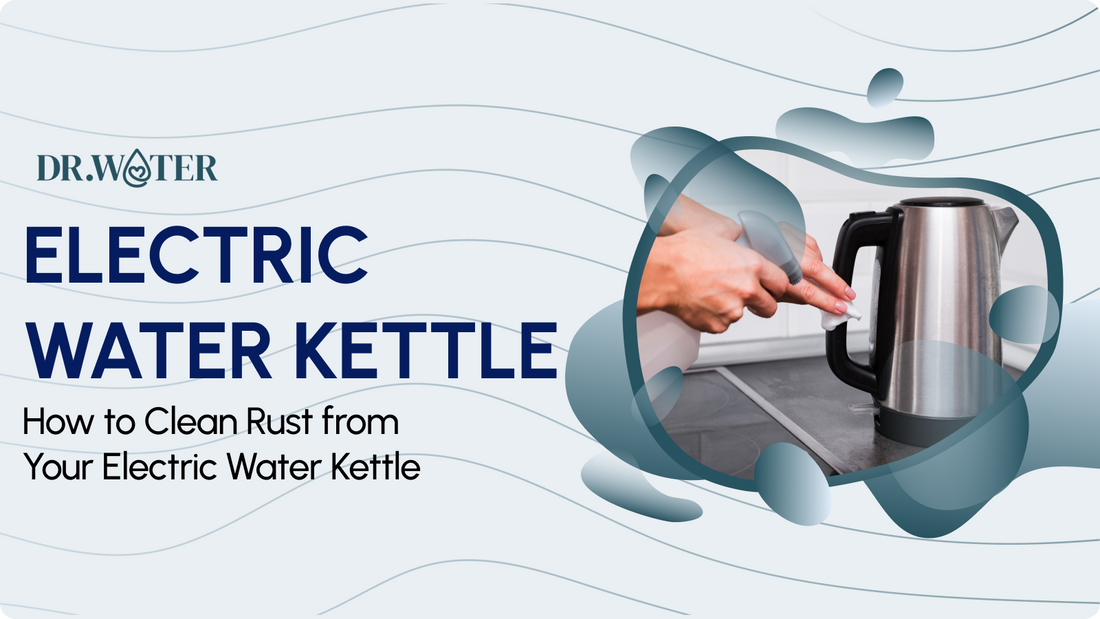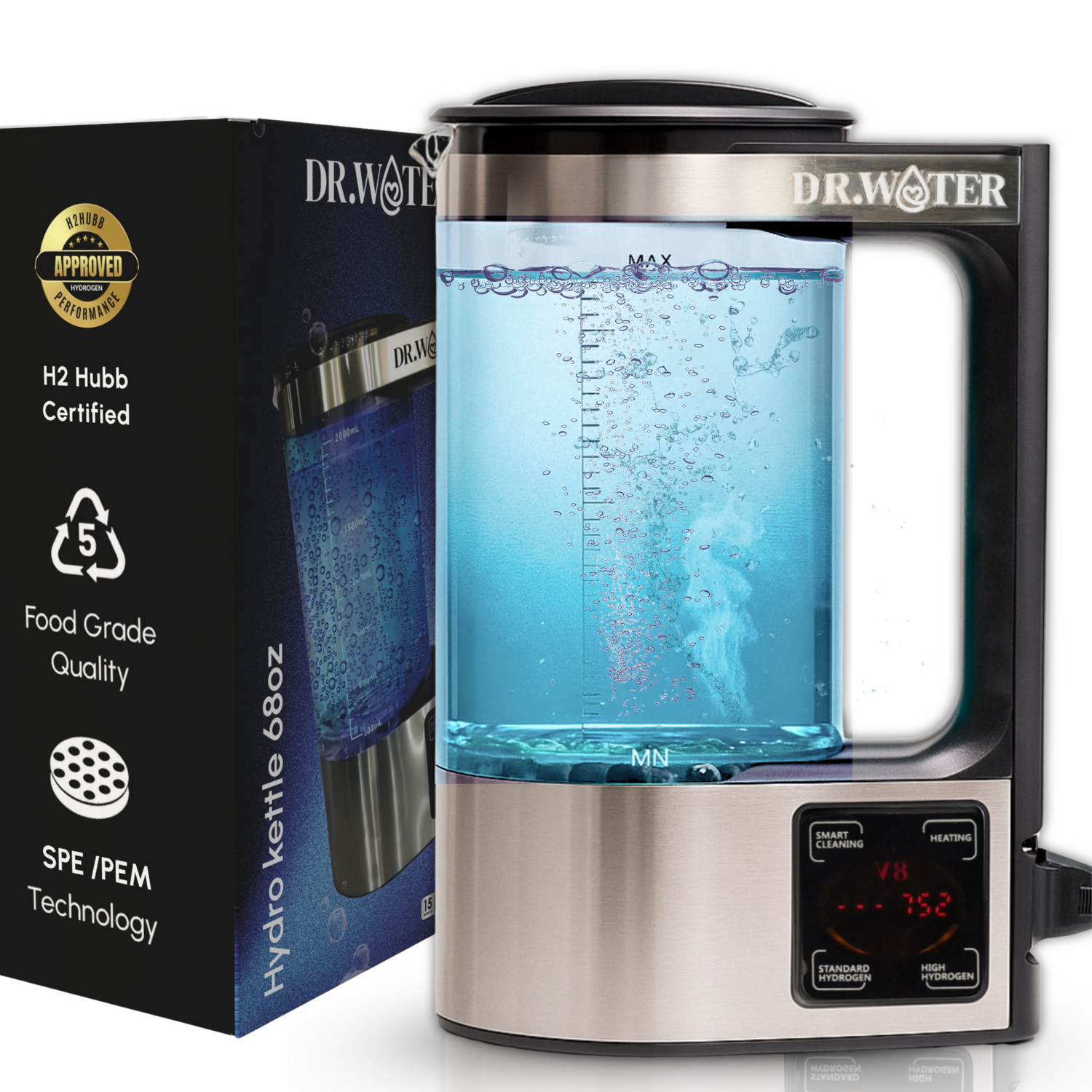
How to Clean Rust from Your Electric Water Kettle
Share
Key Takeaways
|
If you’ve ever looked inside your electric kettle and spotted rusty marks, you’re not alone. Many assume stainless steel kettles can’t rust, but constant contact with water, heat, and minerals can cause corrosion over time.
The good news? Rust doesn’t mean your kettle is done for. With proper cleaning and simple upkeep, you can bring it back to life and keep it spotless for years. This guide covers everything you need to know about removing rust from a water kettle.
Why Does Rust Form in Electric Kettles
Rust, or iron oxide, develops when metal reacts with oxygen and moisture. Even though stainless steel resists corrosion better than regular steel, it’s not immune to it.
Living in a hard water area increases the risk further. Minerals from tap water can build up inside the kettle, causing both limescale and rust that may affect taste, performance, and cleanliness.
In fact, over 85% of homes in the U.S. have hard water, which contains high levels of calcium and magnesium, minerals that accelerate both limescale and rust formation in kettles. Here’s what usually causes rust to appear:
- Hard Water Deposits: Minerals like calcium and magnesium leave residue that speeds up corrosion.
- Constant Moisture Exposure: A damp kettle interior wears down its protective layer, making it vulnerable to rust.
- Water Left Behind: Letting water sit inside promotes oxidation and staining.
- Scratches or Abrasions: Using metal utensils or harsh scrubs can expose raw metal, creating rust spots.
- Low-Grade Materials: Budget kettles often use thinner or lower-quality stainless steel that corrodes faster.
Also Read: 5 Best Electric Kettles for Hard Water
Now that you know what causes rust, it’s worth understanding why getting rid of it matters, not just for looks, but for how your kettle functions.
How Removing Rust Improves Your Electric Kettle
Keeping your kettle rust-free not only protects your water and taste but also maintains the metal’s strength and ensures efficient heating. These benefits make every cup safer, and your kettle lasts longer.
Here’s why removing rust makes a real difference.
- Keeps Your Water Safe: Rust can leach into your water, affecting its taste and quality. A clean kettle means cleaner, fresher water.
- Prevents Damage: Rust buildup can weaken the metal, shortening your kettle’s lifespan. Regular cleaning keeps it in top shape.
- Improves Efficiency: A rust-free kettle heats water faster and more evenly, saving time and energy.
Now, let’s discuss how to remove rust from the water kettle.
3 Ways to Remove Rust from Your Electric Kettle
You don’t need harsh chemicals to clean rust from your kettle. Here are the best natural methods that effectively break down rust:
1. White Vinegar and Water Method (Best for Heavy Rust)

For kettles with stubborn, built-up rust, vinegar cuts through the corrosion and mineral deposits efficiently. Its acidity penetrates deep into rusted spots, making cleanup easier. Let’s break down the steps.
- Fill the kettle with equal parts white vinegar and water (50/50 mixture).
- Boil the solution and let it sit for an hour to dissolve the rust.
- Scrub the inside with a soft sponge or bottle brush to remove loosened rust.
- Rinse thoroughly 2-3 times with fresh water.
- Boil plain water once before using the kettle again.
Why It Works: Vinegar is acidic, which helps dissolve mineral buildup and rust effectively.
2. Baking Soda and Lemon Paste (Gentle and Effective)

If your rust is lighter or you want a more natural approach, baking soda and lemon offer a safe, non-scratching solution. Together, they lift rust while protecting the kettle’s surface. Here’s how to use it.
- Mix 2 tablespoons of baking soda with lemon juice to create a thick paste.
- Apply the paste directly onto rust spots and let it sit for 15-20 minutes.
- Scrub with a soft cloth and rinse well with warm water.
- Boil plain water once before using the kettle again.
- Why It Works: Baking soda is a mild abrasive that removes rust without scratching the steel, while lemon’s acidity helps dissolve oxidation.
3. Hydrogen Peroxide Soak (For Stubborn Rust)

When rust refuses to budge, hydrogen peroxide provides a chemical boost without harsh abrasives. It targets oxidation directly and leaves your kettle residue-free. Follow these simple steps.
- Pour hydrogen peroxide into the kettle, covering rusted areas.
- Let it sit for 30 minutes, and then scrub gently.
- Rinse thoroughly and boil plain water once before using the kettle again.
Why It Works: Hydrogen peroxide breaks down rust chemically without leaving any residue.
Also Read: Using an Electric Kettle to Boil Water: Safety and Procedures
Once your kettle is clean, taking a few simple steps can help stop rust from forming again.
Tips to Prevent Rust Buildup in Your Electric Kettle
Here are some simple ways to keep your electric kettle rust-free and working efficiently:
1. Dry Your Kettle After Each Use
Leaving water sitting in your kettle, especially overnight, can speed up rust formation. After using it, empty it and leave the lid open to let it fully air dry.
2. Use Filtered or Distilled Water
Tap water, especially if it’s high in minerals, can contribute to rust and limescale buildup over time. Switching to filtered or distilled water can significantly slow down this process.
3. Avoid Harsh Scrubbing Tools
While it might be tempting to go at rust with steel wool or a metal scrubber, these can scratch the inside of your kettle, making it more prone to future rusting. Instead, stick to soft sponges or bottle brushes.
4. Regular Preventive Boiling
Once a week, boil a mixture of water and a splash of vinegar or lemon juice in your kettle. This helps prevent rust and mineral buildup before they become a bigger problem.
5. Wipe and Empty the Kettle After Use
After each use, wipe down the inside of your kettle and empty any remaining water. This simple step helps reduce moisture buildup, preventing rust and mold from developing.
Also Read: Is Kettle Water Safe to Drink? Here's What You Should Know
Now, let’s explore an innovative and maintenance-free alternative to traditional electric kettles.
Dr. Water’s HydroPitcher 68oz: A Low-Maintenance Alternative

If you’re tired of constantly cleaning your electric kettle to prevent rust, Dr. Water’s HydroPitcher 68oz offers a convenient, maintenance-friendly option. Unlike traditional kettles, it doesn’t rely solely on boiling.
It gently heats water while infusing it with hydrogen. This process produces clean, hydrogen-rich water that can be added to your beverages for a simple wellness boost.
The HydroPitcher also features:
- Self-Cleaning Function: Smart indicators guide you through a deep-clean cycle, reducing the need for manual scrubbing.
- Safe, Durable Build: Made with borosilicate glass and stainless steel, with platinum-titanium electrodes that resist corrosion and chemical leaching.
- Multi-Mode Hydrogen Infusion: Standard and high modes allow hydrogenation up to 1500 ppb while also offering gentle heating for hot beverages.
- Easy Daily Use: Corded electric design ensures consistent performance and fast preparation, without worrying about rust or mineral buildup.
With HydroPitcher, you get a reliable, low-maintenance solution that complements your wellness routine, keeping your water fresh and clean with no need for frequent scrubbing.
Conclusion
Rust in your kettle doesn’t mean it’s completely ruined. But if you ignore it for too long, it can affect the taste of your water and the overall lifespan of the appliance. A few easy, natural cleaning methods, combined with regular maintenance, can keep your kettle rust-free, working well, and tasting fresh every time.
If you’re looking for a truly low-maintenance option, Dr. Water’s HydroPitcher 68oz has a self-cleaning feature that makes life a lot easier. Just fill it up, and let the advanced tech handle the rest.
Keep your kettle rust-free effortlessly - shop HydroPitcher 68oz now.
FAQs
1. Can rust in a kettle affect my health?
A: While small amounts of rust are unlikely to cause serious health issues, consuming water with rust regularly may affect taste and could irritate the stomach in sensitive individuals.
2. Are there kettles that are naturally more resistant to rust?
A: Yes. Kettles made from high-grade stainless steel, glass, or ceramic are less prone to rust compared to those made from low-quality metals, although regular care is still recommended.
3. Can using flavored or acidic beverages in a kettle increase rust risk?
A: Yes. Juices or liquids with high acidity can corrode the metal faster than plain water, potentially accelerating rust formation inside the kettle.
4. How often should I inspect my kettle for rust?
A: It’s a good idea to check your kettle’s interior at least once a month, especially if you use it daily or live in a hard water area. Early spotting prevents heavy buildup.
5. Can I use the HydroPitcher 68oz daily without worrying about cleaning?
A: Yes. Its smart cleaning indicators and durable materials make it low-maintenance, so you don’t need to scrub it frequently like a traditional kettle.

